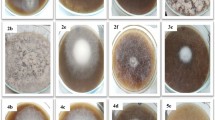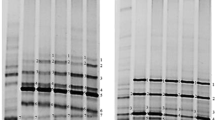Abstract
A microbial community capable of degrading pure cellulose has been isolated from soil using a continuous flow chemostat. The component organisms have been identified as Penicillium nigricans, Paecilomyces liliacinus, Fusarium oxysporum (3 strains), Aspergillus fumigatus, Gliocladium roseum, and Penicillium simplicissimum.
Extracellular enzyme production (exoglucanase, endoglucanase, and (Β-glucosidase) and cellulose breakdown by the whole community and the component organisms in pure culture was measured during growth on pure cellulose in batch culture.
After 30 d, 50–60% degradation was achieved by Penicillium simplicissimum, Aspergillus fumigatus, and the mixed culture. These cultures also produced the highest levels of extracellular endo- and exoglucanase and were able to produce the full enzyme complex necessary for the degradation of crystalline cellulose. The other isolates were capable of 0–20% degradation and produced lower levels of enzyme activity. Most were unable to produce the full enzyme complex.
The results indicated that the whole community was no better at degrading pure cellulose than two members in pure culture. Since the full potential of the community may not be expressed on pure cellulose, breakdown and enzyme production was investigated during growth on lignocellulose. A large proportion of lignocellulosic material consists of xylan and enzymes capable of degrading this component were investigated.
The highest percentage degradation and enzyme production (with the exception of Β-glucosidase) after 15 d growth on straw was achieved by the same three cultures. Studies of their growth on hay and straw were extended over a 60-d period. The rate and extent of degradation of hay by P. simplicissimum and A. fumigatus was similar to that of the mixed culture, more than 40% degradation occurring in 40 d. However, differences in levels of enzyme activity were observed. The mixed culture produced lower levels of enzyme activity (with the exception of Β-glucosidase) particularly during the initial states of degradation. Differences in enzyme production by A. fumigatus and P. simplicissimum were also observed. A. fumigatus produced high levels of xylanase and endoglucanase while P. simplicissimum produced high levels of exoglucanase. Similar results were observed on straw.
The composition of the lignocellulosic material was measured by sequential chemical extraction of the solubles, hemicellulose, cellulose, and lignin. Changes in the composition during degradation were investigated. During the growth of all three cultures on hay, the total percentage of hemicellulose and cellulose decreased from 84% to less than 45% in 40 d.
Despite significant differences in the enzyme activity, P. simplicissimum, A. fumigatus and the mixed culture were capable of degrading lignocellulosic material at the same rate. The production of a full cellulase complex appears to be more important than the production of high levels of individual enzymes.
Similar content being viewed by others
Author information
Authors and Affiliations
Rights and permissions
About this article
Cite this article
Harrison, L.A., Parry, J.B., Lynch, J.M. et al. The Properties of a cellulolytic microbial community growing on pure cellulose and lignocellulose. Appl Biochem Biotechnol 9, 361–362 (1984). https://doi.org/10.1007/BF02798976
Issue Date:
DOI: https://doi.org/10.1007/BF02798976




